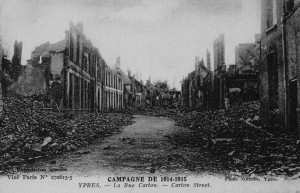
You’re in England standing on the Channel coast in 1916; when the wind is just right you can hear it faintly.
The heavy crump of shells exploding on the Continent.
In just five months two armies exchanged 30 million shells at the Battle of the Somme.
In the four years from 1914 to 1918, 1.45 billion shells were fired.
Deadly mustard gas was contained in 66 million of them.
The cost of producing all those munitions nearly bankrupted all the countries involved.
In one space of 150 days, a million were killed … Germans, British and Canadians.
90,000 British soldiers from the Ypres salient alone have no known grave.
This is World War I, of course.
It’s now a century since the beginning of the war on July 28, 1914.
All of the above comes as a narrative from a local taxi driver in Belgium.
Taxi driver – yes. But he’s also a professional tour guide of WWI battlefields. His real ability is as a master storyteller.
He learned WWI history from his ‘storyteller’ father.
More to that, war history has been passed down in his ‘tour-guide family’ for generations after the armistice.
Since then families have made WWI an occupation that brings alive the events of Ypres, Vimy, Passchendaele, the Somme, Verdun and more for visitors from all over the world.
So with all the above facts still sinking in, you settle yourself into a taxi as your driver continues the narrative.
An all too realistic account of trench warfare makes you feel as vulnerable as a day-one recruit in a rain of bullets.
Your nerves fray with stories of the cold, the snow, bloodied trench knives, night scouting missions and gas mask alerts. They all inflict unease.
You’re drawn in to the atmosphere of a mud-caked front as you see the trenches and hear about gas attacks, bayonet charges and a world bisected with barbed wire and redoubts housing lethal machines guns.
You get a mental picture of the muzzle flashes of howitzers; equally you can almost hear the whine of bullets arriving to penetrate flesh.
Men fall, pierced by hot metal. They’re kids really, some as young as 16. One lad, John Condon, buried near Ypres was supposedly 12 when he enlisted.
You’re with a medic as he staunches wounds and you’re with officers as they peer over the top of sandbagged trenches with periscopes to evaluate enemy strength.
White phosphorus shells burst overhead; three young men are blinded for life. A life that unfortunately lasts just minutes more in a melee of bullets and shells.
You can readily imagine cowering against an earthen wall and reading a Bible that changed hands each time its previous over was killed.
It’s a Bible that’s ‘many-men-old’, the taxi driver adds.
You hear about the unexploded shells that are found to this day. Farmers plowing fields regularly turn them up.
In fact, a huge tonnage of ammunition has been unearthed over the last thirty years.
In 2004, 3,000 unexploded German shells were discovered at a site near Ypres.
Strange that the present should contain all that.
Where there are now tranquil woodlands, you’re shown war photos of the same spot in 1916 with not a tree to be seen.
Shellfire leveled everything.
As you listen, you can visualize the arrival of coal miners who had just finished tunneling under London to build the new Underground Railway.
To initiate a breakthrough, they dug under no man’s land to reach the German trenches to pack the tunnels with tons of high explosives and set them off.
Of course, the Germans tunneled just as enthusiastically and when shafts met, so did opposing armies.
With these stories, the driver also relates happier moments.
Soldiers were known to pack colorful womens’ party dresses and wigs to bring into the trenches.
In the ruins of war they’d sing and dance for weary soldiers in a caricature of high-kicking chorus girls.
It helped. ‘Remarkably so’, says the taxi driver.
So all this is a taxi ride?
Actually it’s storytelling at its best even if the sight and sound of it is gruesome.
It made us think about marketing and advertising and the way we communicate with our customers and prospects.
The problem with most ad campaigns? People don’t have the time to ignore them.
Too often this is because marketers see their brand one way while the target audience sees it another way.
But a story gives you a better chance of gaining pulling power and engagement.
Instead of advertising you have something both meaningful and enduring.
You’re drawing your audience in.
Just like a Belgian taxi driver who knows how to make you listen to every word.
The power of stories. Are you using them to fuel your messaging? Leave your comment below. Thanks for reading Whybetonto.com. Regards, Steve Ulin LinkedIn: http://linkd.in/1Bey3Jl